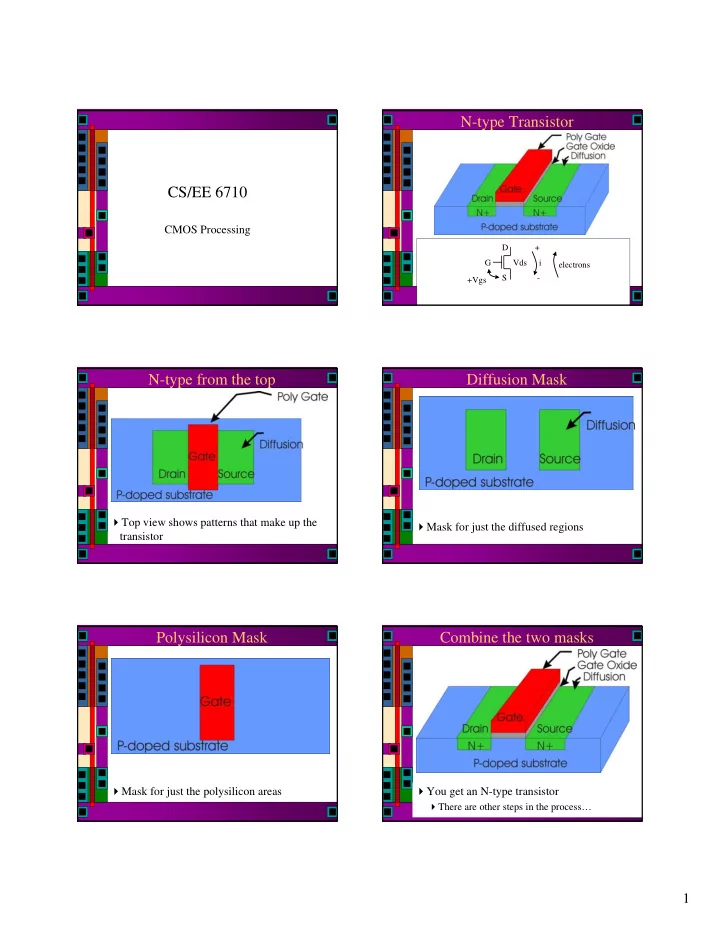

N-type Transistor CS/EE 6710 CMOS Processing D + G Vds i electrons S - +Vgs N-type from the top Diffusion Mask � Top view shows patterns that make up the � Mask for just the diffused regions transistor Polysilicon Mask Combine the two masks � Mask for just the polysilicon areas � You get an N-type transistor � There are other steps in the process… 1
A Cutaway View Look at Inverter Layout Again � CMOS structure with both transistor types � How many layers? � How many processing steps? Photolithography Photolithographic Process � Oxidation Layer UV Light � Photoresist (PR) Coating � Stepper Exposure � PR development and bake � Acid Etching � Spin, Rinse, Dry � Processing step � PR removal (ashing) Photolithographic Process Photolithographic Process 2
Photolithographic Process Photolithographic Process Photolithographic Process Photolithographic Process Growing the Silicon Crystal Czochralski Method � Need single-crystal silicon to accept impurities correctly � Donor elements provide electrons � Acceptor elements provide holes � Pull a single crystal of silicon from a puddle � Need single crystal structure of molten polycrystalline silicon � Single crystal vs. Polycrystalline silicon (Poly) 3
Slice Crystal into Wafers Lapping and Polishing � Slice into thin wafers (.25mm - 1.0mm), and polish to remove all scratches Oxidation, Growing SiO2 Making the Mask � Essential property of silicon is a nice, easily grown, insulating layer of SiO2 � Use for insulating gates (“thin oxide”) � Also for “field oxide” to isolate devices Adding Photoresist “Steppers” Expose the Mask � Use very short wavelength UV light � Photoresist can be positive or negative � Single frequency, 436 - 248 nm � Does the exposed part turn hard, or the � Expensive! ~$5,000,000/machine… unexposed part? 4
Develop and Bake Photoresist Now Etch the SiO2 � Developed photoresist is soft, unexposed is hardened � Etch the SiO2 to expose the wafer for � So you can etch away the soft (exposed) part processing � Then Spin Rinse, and Dry Add a Processing Step Ion Implantation � Now that we’ve got a pattern etched to the right level, we can process the silicon � Could be: � Ion Implantation (I.e. diffusion) � Chemical Vapor Deposition (silicide, Poly, insulating layers, etc.) � Metal deposition (evaporation or sputtering) � Copper deposition (very tricky) � Implant ions into the silicon � Donor or Acceptor Chemical Vapor Deposition Metal Deposition � Typically aluminum, gold, tungsten, or alloys 5
Advanced Metalization Copper is Tricky � 40% less resistance than Aluminum � 15% system speed increase � But, copper diffuses into Silicon and changes the electrical properties Ashing - Removing Photoresist Final Layer: Passivation � Basically a final insulating layer (SiO2 or Si3N4) to protect the circuit CMOS Fabrication Self-Aligned Gates � Start from single-crystal silicon wafer � Thinox in active regions, thick � Use photolithography to pattern device layers elsewhere � Essentially one mask/photolithographic sequence � Deposit Polysilicon per layer � Built (roughly) from the bottom up � 6 - Metal 3 � Etch thinox from � 5 - Metal 2 Via active region (Poly � 4 - Metal 1 Via serves as mask for � 2 - Polysilicon Exception etch/diffusion) � 3 - Diffusions Contact � 1 Tub (N-well) � Implant dopant 6
CMOS Inverter N-well Mask Active Mask Poly Mask N+ Select Mask P+ Select Mask 7
Contact Mask Metal Mask Other Cutaway Views Another View of Fab � Taken from slides by Jan Rabaey � From his text “Digital Integrated Circuits” Circuit Under Design Circuit Layout V DD V DD M 2 M 4 V out V out 2 V in M 3 M 1 This two-inverter circuit (of Figure 3.25 in Rabaey’s text ) will be manufactured in a twin-well process. 8
Start Material N-well Construction A Starting wafer: n-type with (1) Oxidize wafer doping level = 10 13 /cm 3 A’ (2) Deposit silicon nitride (3) Deposit photoresist * Cross-sections will be shown along vertical line A-A’ N-well Construction N-well Construction (5) Develop resist (4) Expose resist using n-well mask (6) Etch nitride and (7) Grow thick oxide N-well Construction P-well Construction (8) Implant n-dopants (phosphorus) Repeat previous steps (up to 1.5 μ m deep) 9
Grow Gate Oxide Grow Thick Field Oxide 0.9 μ m thick 0.055 μ m thin Uses Active Area mask Is followed by threshold-adjusting implants Polysilicon layer Source-Drain Implants n+ source-drain implant (using n+ select mask) Source-Drain Implants Contact-Hole Definition (1) Deposit inter-level dielectric (SiO 2 ) — 0.75 μ m p+ source-drain implant (2) Define contact opening (using p+ select mask) using contact mask 10
Aluminum-1 Layer Aluminum evaporated (0.8 μ m thick) followed by other metal layers and glass 11
Recommend
More recommend